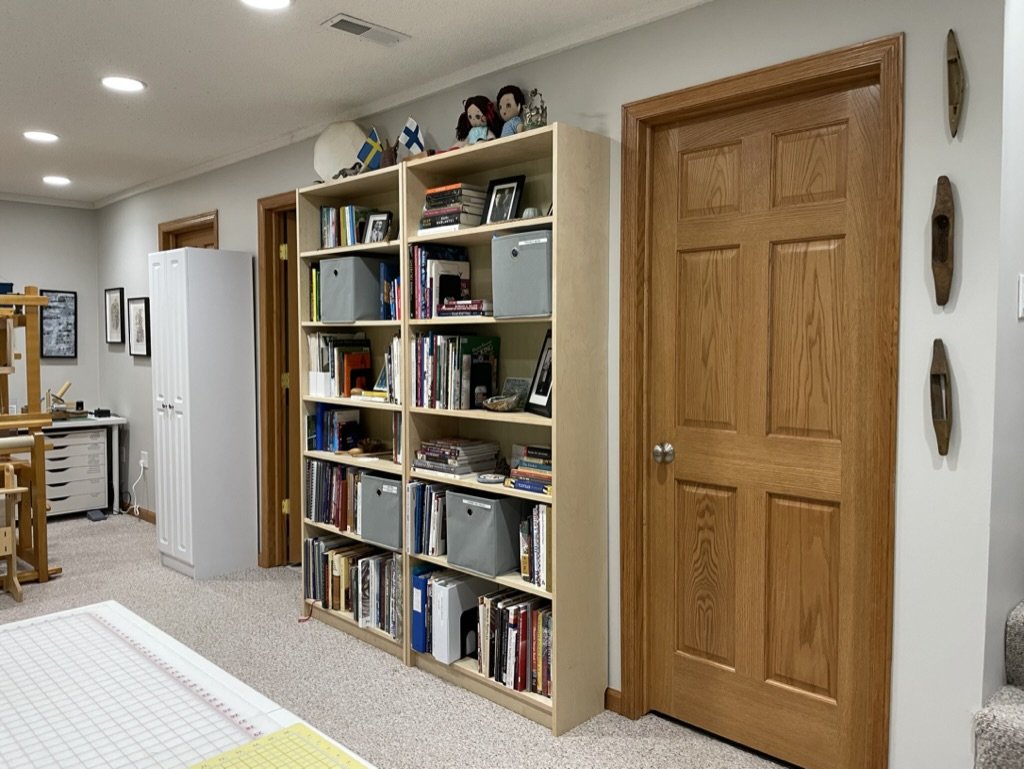It has taken me longer than I imagined to settle into my studio. I mostly had things unpacked and in place at the end of August after we moved in July. There have been small tweaks and some equipment came and went. Shelves were built, worktables in place and yet it didn’t quite feel right. I didn’t feel really compelled to be in the space and I wasn’t quite sure what was going on.
Design wall to the left. Fabrics stick to the flannel so they can be viewed, photographed and observed. Quote on this wall is from a Mary Oliver poem. Work table and drawers to the right.
When winter set into the land of 10,000 now frozen lakes, I figured I’d go heads down to work. I did for the most part, but I felt unfocused and meh about a lot of things. Last week that began to change. I added another bookcase to capture the height of the room. It allowed my reference books to spread out more, keepsake display space and supply bins to hide clutter to now have a place. They are easily reachable, but visually the shelves are clean.
Antique shuttles that I’ve been given. So many books!
My poor parents would be amused to know that as I’ve gotten older, I’ve become more fastidious about mess and clutter. I’ve worked in a variety of studio spaces, some shared and I know I work best in clean spaces.
Work tables for various tasks. Computer area items can be condensed for hand stitching as well.
This weekend my husband and I built another bookshelf for the space behind my loom for yarn storage. I had a shorter shelf there before and the whole area was a bit of a chaotic disaster. Now I have covered storage for colored yarns, shelves for white coned yarns and the clutter has a place to go. Most of it was rehomed into my storage area as we moved the smaller shelf there.
Main weaving area. Tools for weaving in the drawers, yarn in the cabinets and winding items for yarns on the table area.
Next, we painted the bathroom. Before it was a late 90s/early 2000 shade of dark teal with dim lighting. We painted it the same color as the studio walls and installed daylight bulbs above the vanity. It is transformed and it just feels better. There is a ridiculous amount of storage in this bathroom. The vanity drawers are full of shop towels, measuring spoons and cups, the cupboard holds drop cloths, dye powders and the shower has bins and a rolling cart tucked inside. I feel very fortunate to have a space with a wet area. The shower makes an excellent place to tuck wet yarns and fabric into for drying.
The bathroom that offers more artwork display space! A large and hidden drawer on the vanity base offers more storage. I didn’t discover it until a few weeks ago.
Today’s project was to reclaim the space under my main worktables. We had a four shelf wire unit that was sitting unused. I measured it and realized it would be perfect under the tables as two units with two shelves. It now holds rolled textiles, shipping box with pool noodles for textiles rolls, and various other things that I need here and there.
Captured space with room to grow.
I’m all about capturing as much space as I can in studios. Textiles is an equipment dense pursuit and the clutter of it can be overwhelming. Finding a home for each tool or supply takes time and there are many tweaks. I get annoyed when I go to look for something and can’t find it. It’s inefficient and can break the workflow. One of my favorite studio tools is a label maker. All drawers and closed storage bins are labeled.
Sewing area with printer tucked under. Printer shelf is on wheels now so it can be pulled out for expanded use. Rolling cart has weaving yarns that can be moved when I’m at the loom.
One of my favorite thing in my studio can be found in the storage closet. I used a small wire rack to organize loom reeds and tools. I don’t know why but speciality reed storage are crazy expensive.
It isn’t a Pinterest studio space for the most part. The main workspace is organized, clean and spacious given what I have in it. There are tight areas around the loom, but it works.
And I’m working too. I feel excited to get to the space in the morning and I’m finding it hard to leave at night. I like being in the space, ideas are flowing, and I’ve started making a daily list of tasks I hope to get to that day.
On the list for tomorrow is this weaving that I began in the last post. It is off the loom, and I have some hemming to do before doing some more work on it. Will it be a piece? I don’t know, but there is an idea there that calls to me. So, work will begin on it tomorrow.
Another favorite part of my studio is this saying above the utility room door.
“Minä istun iloissani ja annan surun huilata.”
“I sit here contented while sorrow catches its breath.”
The Finnish saying came from a letterpress artwork that we have framed in another part of the house. I had a bit of an exchange with a Finnish instructor, and he thought that contented wasn’t a strong enough word – delighted, maybe. I’ll stick with contented. It seems like a deeper more lasting feeling. I’ve found it here in the wild and wintery north.
The marsh is frozen over while we bask in the sunshine.





















